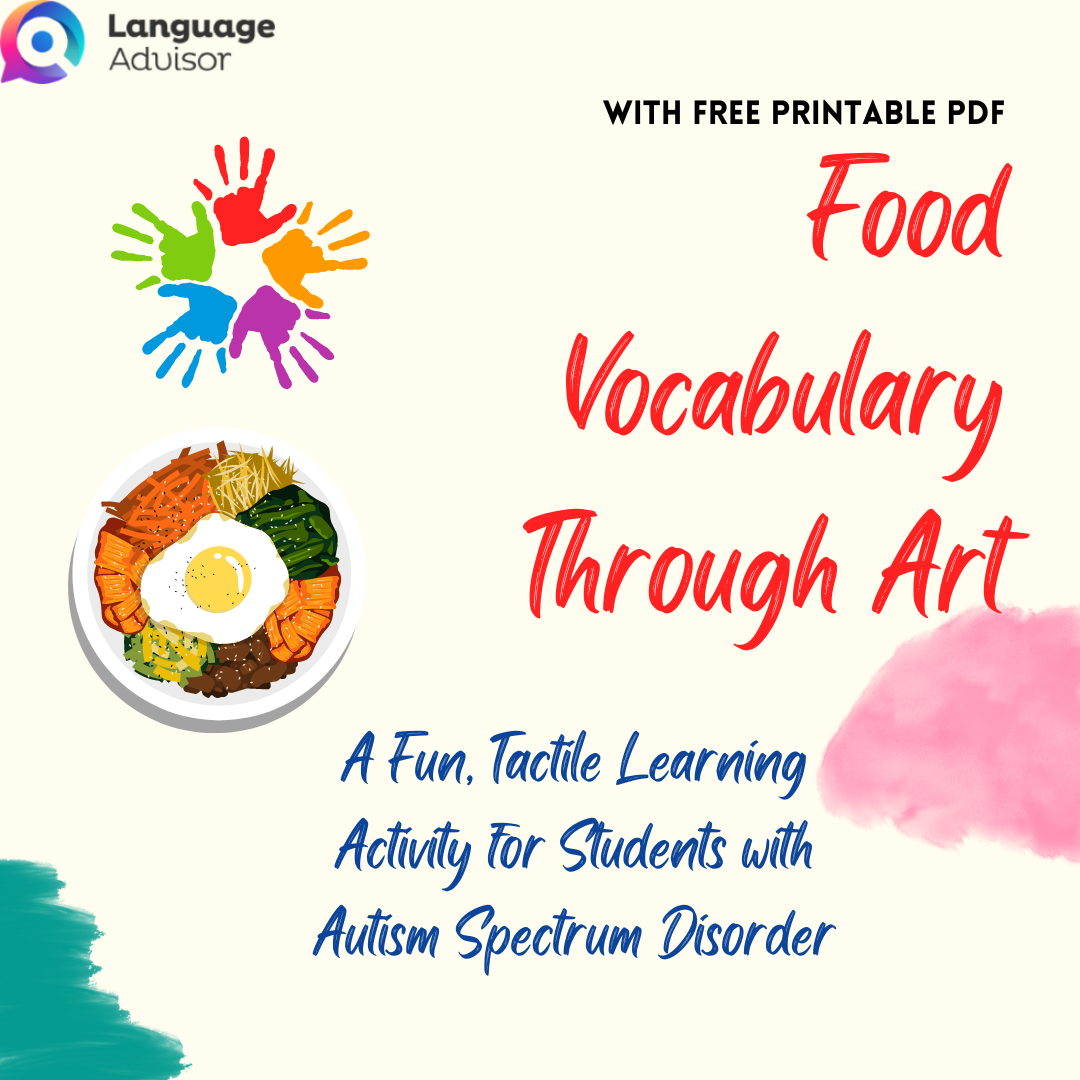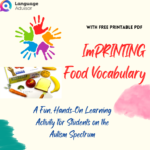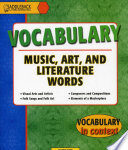Food Vocabulary Through Art: A Fun, Tactile Learning Activity for Students with Autism Spectrum Disorder (With Free Printable PDF)
Food Vocabulary Through Art

Food Vocabulary Through Art
This lesson focuses on reinforcing food vocabulary by creating an art print while encouraging tactile exploration. Designed for students with autism spectrum disorder (ASD), this activity blends vocabulary practice with sensory play and fine motor development. Follow these steps to engage students in learning while creating their own art pieces using food stamps.
Skills Practiced:
- Key Food Vocabulary
- Tactile Sensory Processing
- Fine Motor Skills
Materials:
- Language Builder 3D – 2D Animal Matching Kit
- Target Food (Choose from apple, banana, broccoli, carrots, corn, orange, bread, or cookie)
- Paper Bag (or Cloth Sack)
- Washable Paint
- 18” x 24” Construction Paper
- Smock
- Paper Plate (or Reusable Container)
People:
This activity is appropriate for one-on-one instruction or a small group of learners.
Set-Up:
Part I: Matching Game (Floor)
- Layout one of each 2D food card in a line.
- Create a stack with the remaining 8 2D food cards.
- Place one of each 3D food item into the sack. (Note: The remaining 3D foods won’t be used.)
Part II: Art Project (Table)
- Fill a paper plate with about ¼ inch of paint for each student.
- Cut the target food in half and place it on a new plate next to the paint (one per student).
- Write each student’s name on the back of their construction paper.
- Layout paper for the demo and for each student.
Procedures:
Part I: Matching Game
- Game Introduction:
- Have students sit in a semi-circle, facing the teacher.
- The teacher explains that the goal of this game is to practice food words.
- Reinforcing Vocabulary:
- The teacher points to each of the 2D food cards in the line and says the name.
- The teacher repeats the process, inviting students to say the names together.
- Encourage and reinforce correct answers by saying, “Yay!” or “You did it!”
- Matching:
- The teacher models selecting a 2D food card from the stack and placing it on its match.
- Invite students to repeat the food name together.
- Students take turns selecting a 2D card from the stack and placing it on the match. Each time, the class repeats the food name together.
- 3D Foods:
- The teacher pulls a 3D food from the sack and places it on top of the matching 2D food card.
- Invite students to repeat the name together.
- Students take turns selecting a 3D food and placing it on the match.
Part II: Art Project
- Introduction to Art:
- The teacher shows students the target food of the day (uncut).
- Students repeat the food name together.
- The teacher slices the food in front of the students and explains the new art word: printmaking.
- Demonstration:
- The teacher models stamping paper with food, making a mistake by wiggling the food, and explains how this makes it hard to see the food’s shape.
- The teacher then shows correct stamping (no wiggling), filling the page with stamps that do not touch.
- Emphasize that all art is good, and it’s wonderful if the students’ art looks different.
- Creating Art:
- Each student receives their pre-cut food stamp.
- Students create their art using the printmaking stamp technique, saying the food vocabulary word each time they stamp their paper.
Tips and Variations:
- Tactile Senses: Some students may be uncomfortable touching the food stamps with bare hands. Offer plastic gloves, or use a corn holder or fork as a handle.
- Pre-Cutting Stamps: Some foods work better when cut in halves, quarters, or slices. Test different foods before the lesson.
- Easy Clean-Up: Use trays instead of newspaper to avoid sensory overload. Trays also make clean-up easier.
- Building on Learning: Play the matching game every day until each food card has been featured. Use new colors to stamp over the same piece of art, creating a layered masterpiece.
- Reinforcing Learning: Hang student artwork on the wall with matching 2D food cards. Display photos of students completing the activity next to their art.
- Social Skills: For group sessions, encourage students to look at each other’s art and share positive comments while naming the foods.
Wrap-Up:
- After completing the activity, invite each student to share their favorite food.

DOWNLOAD THE PDF FOR FREE





